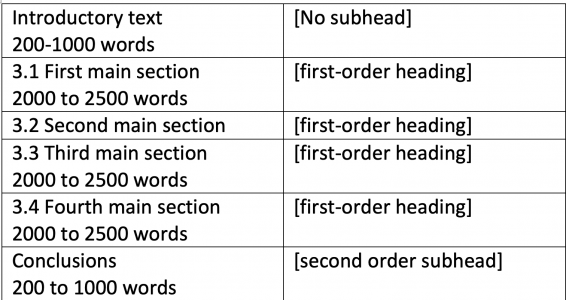Dissertations vary in format, style, and content across disciplines, and as doctoral education evolves, these variations are subject to change. Two common forms of dissertation are the “big book thesis” of 60,000 to 100,000 words (traditional) and the papers model, where the student writes four or five papers of “publishable quality” with a total of approximately 60,000 words (Dunleavy, 2003, p. 5). Joined papers usually require an introduction and a conclusion to make them into a cohesive whole. This blog post discusses the “dissertation by publication model.” Although these two formats pose different problems for the writer, there are structural challenges common to both.
Structure types
Some disciplines have a built-in expectation of structure; for example in the Social Sciences, you may be expected to use the template Introduction/ Literature Review/ Methods/ Results/ Discussion/ Conclusion. In English, you might be expected to produce a topic dissertation of six or more chapters, with several topic chapters sandwiched between the introduction and conclusion.
How to structure your dissertation
Dunleavy is an excellent source on organization. Reading chapters 3 (Planning an integrated thesis) and 4 (organizing a chapter or paper) can help you to understand the overall and chapter level organizational challenges and how to approach them. His book, Authoring a PhD, is in our library (LB2369 D85). Following are key points from those chapters. And following those summaries are some other considerations about structure.
Chapter 3:
- In a typical big book dissertation of 80,000 words, you will have roughly 8 chapters of 10,000 words each. The opening or “lead in” material (one-to two chapters) sets up the core material so it can be understood. “Lead out materials…provid[e] an integrating summation or restatement of what has been found, and set[s] it in a wider context” (p. 50).
- Your core chapters (five) report on your original research, and all other material should be cued to highlight this “value-added material” (p. 52).
- Ensure none of your chapters is out of balance re: length. Vary 2000 words on either side (i.e., 8,000-12,000), but do not include any too-short chapters or too long ones—your readers need to know what to expect.
- Don’t delay the interesting/ core material too long; this can happen when you have an overly long literature review.
- Create a rolling synopsis early in your program in which you lay out your chapter plan in 3-4 pages. Continually revise this as you write and the dissertation evolves. The rolling synopsis is a useful document to show your committee and others.
- Chapters need to be “chunked” so readers can follow; chunking is accomplished by splitting into component parts with a common theme (p. 77).
- Basic principle of chunking: Ensure the parts are of roughly equal size.
- Rule of thumb: You’ll need a “major heading to break up the text every 2000 to 2500 words,” (p. 77) (see the image above) so four sections in a 10,000 (average) chapter.
- These four headings are “first order” headings, the top level of organization. When your parts are of roughly equal size, your readers will know what to expect.
- Make these headings stand out by numbering (3.1, 3.2, etc.), using a larger font, or locating them on a line by themselves. [Make your headings carry meaning. See Thomson and Kamler, 2016, pp. 173-176.]
- Dunleavy recommends second level and possibly third level headings to further chunk your text, as necessary.
- Common problems are when writers under organize (too few parts for the length), over organize (too many small parts and an “overcomplex hierarchy of headings” [p. 82]), and organize chapters differently (inconsistent heading format).
- Every chapter should include the following elements:
- a chapter title;
- some form of ‘high impact’ start element, designed to particularly engage readers’ attention;
- a piece of framing text which moves from the start element to some discursive comments on the chapter’s main substantive themes, leading up to;
- a set of signposts to readers about the sequence and topic focus of the chapter’s main sections (the is, those parts which have first-order headings). (p. 91)
- Read Dunleavy’s text to learn much more.
A different perspective on structuring your dissertation
- Dunleavy’s advice (above) helps you know what to aim for in your finished product. However, Thomson and Kamler (2016) provide a different perspective. Draft chapter headings can provide writing outlines to guide you, but beware of allowing form to dictate content. Thomson and Kamler propose that you let form follow function—attend to the content of your dissertation before you decide on its final form. This may seem counter-intuitive. The urge is to make an outline and create a preliminary table of contents, allowing that structure to guide your writing. Instead, Thomson and Kamler urge you to use your writing as a form of research to explore your ideas and not prematurely close off any interesting lines of inquiry.
- You may find it useful to write freely first, then employ a reverse outline, explained cogently by Rachael Cayley, to organize your text.
Other recommended resources:
- In her chapter “Structural Designs” in Stylish Academic Writing, Helen Sword compares traditional structures in academic writing with more creative approaches (pp. 122-134).
- In “The Music of Form,” Peter Elbow muses on the temporal aspects of writing forms, using Fish’s claim that “everything depends on the temporal dimension” as his foundation.
- In From Dissertation to Book, William Germano offers an excellent chapter on shaping your writing: “Getting into Shape” (pp. 79-100).
Can you recommend any other resources on organization? Email Madeline at caceal4@uvic.ca
Page written by Madeline Walker; last updated February 2, 2023.
